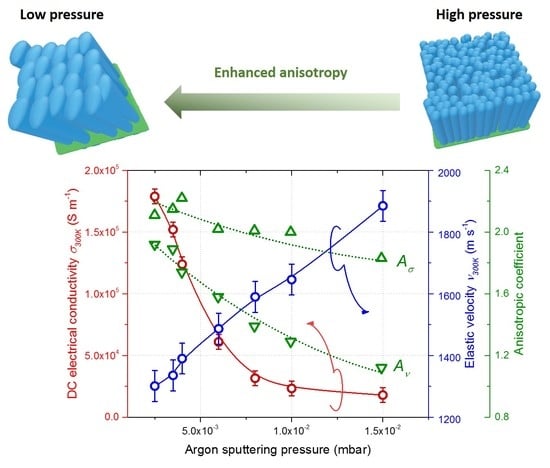Influence of Thickness and Sputtering Pressure on Electrical Resistivity and Elastic Wave Propagation in Oriented Columnar Tungsten Thin Films
Abstract
1. Introduction
2. Materials and Methods
3. Results and Discussion
3.1. First Series: Thickness from 50 to 1000 nm
3.1.1. Morphology and Structure
3.1.2. Electrical Resistivity
3.1.3. Elastic Wave Propagation
3.2. Second Series: Sputtering Pressure from 2.5 × 10−3 to 15 × 10−3 mbar
3.2.1. Morphology and Structure
3.2.2. Electrical Resistivity
3.2.3. Elastic Wave Propagation
4. Conclusions
Author Contributions
Funding
Acknowledgments
Conflicts of Interest
References
- Baranovski, S. Charge transport in disordered solids with applications in electronics; John Wiley & Sons Ltd.: Hoboken, NJ, USA, 2006. [Google Scholar]
- Wu, T.T.; Huang, Z.G.; Lin, S. Surface and bulk acoustic waves in two-dimensional phononic crystal consisting of materials with general anisotropy. Phys. Rev. B 2004, 69, 094301. [Google Scholar] [CrossRef]
- Lundstrom, M. Fundamentals of Carrier Transport; Cambridge University Press: Cambridge, UK, 2000. [Google Scholar]
- Guo, L.; Ren, Y.; Kong, L.Y.; Chim, W.K.; Chiam, S.Y. Ordered fragmentation of oxide thin films at submicron scale. Nat. Commun. 2016, 7, 13148. [Google Scholar] [CrossRef]
- Luo, Z.; Maassen, J.; Deng, X.; Du, Y.; Garrelts, R.P.; Lundstrom, M.S.; Ye, P.D.; Xu, X. Anisotropic in-plane thermal conductivity observed in few-layer black phosphorus. Nat. Commun. 2015, 6, 8572–8578. [Google Scholar] [CrossRef] [PubMed]
- Belardini, A.; Centini, M.; Leahu, G.; Hooper, D.C.; Voti, R.L.; Fazio, E.; Haus, J.W.; Sarangan, A.; Valev, V.K.; Sibilia, C. Chiral light intrinsically couples to extrinsic/pseudo-chiral metasurfaces made of tilted gold nanowires. Sci. Rep. 2016, 6, 31796–31799. [Google Scholar] [CrossRef] [PubMed]
- Zhu, G.; Liu, J.; Zheng, Q.; Zhang, R.; Li, D.; Banerjee, D.; Cahill, D.G. Tuning thermal conductivity in molybdenum disulfide by electrochemical intercalation. Nat. Commun. 2016, 7, 13211–13219. [Google Scholar] [CrossRef] [PubMed]
- Probst, P.T.; Sekar, S.; König, T.A.F.; Formanek, P.; Decher, G.; Fery, A.; Pauly, M. Highly oriented nanowire thin films with anisotropic optical properties driven by the simultaneous influence of surface templating and shear forces. ACS Appl. Mater. Interfaces 2018, 10, 3046–3057. [Google Scholar] [CrossRef] [PubMed]
- Vergara, J.; Favieres, C.; Magen, C.; Teresa, J.M.; Ibarra, M.R.; Madurga, V. Structurally oriented nano-sheets in Co thin films: Changing their anisotropic physical properties by thermally induced relaxation. Materials 2017, 10, 1390. [Google Scholar] [CrossRef]
- Mohanty, B.; Ivanoff, T.A.; Alagoa, A.S.; Karabacak, T.; Zou, M. Study of the anisotropic frictional and deformation behavior of surfaces textured with silver nanorods. Tribol. Int. 2015, 92, 439–445. [Google Scholar] [CrossRef]
- Sun, Y.; Xiao, X.; Xu, G.; Dong, G.; Chai, G.; Zhang, H.; Liu, P.; Zhu, H.; Zhan, Y. Anisotropic vanadium dioxide sculptured thin films with superior thermochromic properties. Sci. Rep. 2013, 3, 2756. [Google Scholar] [CrossRef]
- Krausch, G.; Magerle, R. Nanostructured thin films via self-assembly of block copolymers. Adv. Mater. 2002, 14, 1579–1583. [Google Scholar] [CrossRef]
- Hawkeye, M.; Taschuk, M.T.; Brett, M.J. Glancing Angle Deposition of Thin Films—Engineering the Nanoscale; Wiley: Hoboken, NJ, USA, 2014. [Google Scholar]
- Plawsky, J.L.; Kim, J.K.; Schubert, E.F. Engineered nanoporous and nanostructured films. Mater. Today 2009, 12, 36–45. [Google Scholar] [CrossRef]
- Grüner, C.; Liedtke, S.; Bauer, J.; Mayr, S.G.; Rauschenbach, N. Morphology of thin films formed by oblique physical vapor deposition. ACS Nano Mater. 2018, 1, 1370–1376. [Google Scholar] [CrossRef]
- Robbie, K.; Brett, M.J.; Lakhtakia, A. Chiral sculptured thin films. Nature 1996, 384, 616–617. [Google Scholar] [CrossRef]
- Song, C.; Larsen, G.K.; Zhao, Y. Anisotropic resistivity of tilted silver nanorod arrays: Experiments and modeling. Appl. Phys. Lett. 2013, 102, 233101–233104. [Google Scholar] [CrossRef]
- Charles, C.; Martin, N.; Devel, M. Optical properties of nanostructured WO3 thin films by glancing angle deposition: Comparison between experiment and simulation. Surf. Coat. Technol. 2015, 276, 136–140. [Google Scholar] [CrossRef]
- Martin, N.; Sauget, J.; Nyberg, T. Anisotropic electrical resistivity during annealing of oriented columnar titanium films. Mater. Lett. 2013, 105, 20–23. [Google Scholar] [CrossRef]
- Garcia-Martin, J.M.; Alvarez, R.; Romero-Gomez, P.; Cebollada, E.; Palmero, A. Tilt angle control of nanocolumns grown by glancing angle sputtering of variable argon pressures. Appl. Phys. Lett. 2010, 97, 173103–173113. [Google Scholar] [CrossRef]
- Mukherjee, S.; Gall, D. Structure zone model for extreme shadowing conditions. Thin Solid Films 2013, 527, 158–163. [Google Scholar] [CrossRef]
- Lintymer, J.; Gavoille, J.; Martin, N.; Takadoum, J. Glancing angle deposition to modify microstructure and properties of chromium thin films sputter deposited. Surf. Coat. Technol. 2003, 174, 316–323. [Google Scholar] [CrossRef]
- Bierwagen, O.; Pomraenke, R.; Eilers, S.; Masselink, W.T. Mobility and carrier density in materials with anisotropic conductivity revealed by van der Pauw measurements. Phys. Rev. B 2004, 70, 165307. [Google Scholar] [CrossRef]
- Coffy, E.; Dodane, G.; Euphrasie, S.; Mosset, A.; Vairac, P.; Martin, N.; Baida, H.; Rampnoux, J.M.; Dilhaire, S. Anisotropic propagation imaging of elastic waves in oriented columnar thin films. J. Phys. D: Appl. Phys. 2017, 50, 484005–484008. [Google Scholar] [CrossRef]
- Royer, D.; Dieulesaint, D. Ondes élastiques dans les solides Ⅱ: Génération, interaction acoustico-optique, applications; Elsevier Masson: Paris, France, 1996. [Google Scholar]
- Biot, M.A. Theory of propagation of elastic waves in a fluid-saturated porous solid. II. Higher frequency range. J. Acoust. Soc. Am. 1956, 28, 179–191. [Google Scholar] [CrossRef]
- Da Fonseca, R.J.M.; Saurel, J.M.; Foucaran, A.; Camassel, J.; Massone, E.; Taliercio, T.; Boumaiza, Y. Acoustic investigation of porous silicon layers. J. Mater. Sci. 1995, 30, 35–39. [Google Scholar] [CrossRef]
- Aliev, G.N.; Goller, B.; Snow, P.A. Elastic properties of porous silicon studied by acoustic transmission spectroscopy. J. Appl. Phys. 2011, 110, 43534–43541. [Google Scholar] [CrossRef]
- Reinhardt, A.; Snow, P.A. Theoretical study of acoustic band-gap structures made of porous silicon. Phys. Status Solidi 2007, 204, 1528–1535. [Google Scholar] [CrossRef]
- El Beainou, R.; Martin, N.; Potin, V.; Pedrosa, P.; Arab Pour Yazdi, M.; Billard, A. Correlation between structure and electrical resistivity of W-Cu thin films prepared by GLAD co-sputtering. Surf. Coat. Technol. 2017, 313, 1–7. [Google Scholar] [CrossRef]
- Karabacak, T.; Singh, J.P.; Zhao, Y.P.; Wang, G.C.; Lu, T.M. Scaling during shadowing growth of isolated nanocolumns. Phys. Rev. B 2003, 68, 125408. [Google Scholar] [CrossRef]
- Alvarez, R.; Garcia-Martin, J.M.; Garcia-Valenzuela, A.; Macias-Montero, M.; Ferrer, F.J.; Santiso, J.; Rico, V.; Cotrino, J.; Gonzalez-Elipe, A.R.; Palmero, A. Nanostructured Ti thin films by magnetron sputtering at oblique angles. J. Phys. D: Appl. Phys. 2016, 49, 045303. [Google Scholar] [CrossRef]
- Maillé, L.; Sant, C.; Le Paven-Thivet, C.; Legrand-Buscema, C.; Garnier, P. Structure and morphological study of nanometer W and W3O thin films. Thin Solid Films 2003, 428, 237–241. [Google Scholar] [CrossRef]
- Choi, D. Phase transformation in thin tungsten films during sputter deposition. Microelectron. Eng. 2017, 183, 19–22. [Google Scholar] [CrossRef]
- Petroff, P.; Sheng, T.T.; Sinha, A.K.; Rozgonyi, G.A.; Alexander, F.B. Microstructure, growth, resistivity, and stresses in thin tungsten films deposited by rf sputtering. J. Appl. Phys. 1973, 44, 2545–2554. [Google Scholar] [CrossRef]
- El Beainou, R.; Salut, R.; Robert, L.; Cote, J.M.; Potin, V.; Martin, N. Anisotropic conductivity enhancement in inclined W-Cu columnar films. Mater. Lett. 2018, 232, 126–129. [Google Scholar] [CrossRef]
- Kaidatzis, A.; Psycharis, V.; Mergia, K.; Niarchos, D. Annealing effects on the structural and electrical properties of sputtered tungsten thin films. Thin Solid Films 2016, 619, 61–67. [Google Scholar] [CrossRef]
- Lide, D.R. CRC Handbook of Chemistry and Physics; CRC Press: Boca Raton FL, USA, 2005. [Google Scholar]
- Besnard, A.; Martin, N.; Carpentier, L.; Gallas, B. A theoretical model for the electrical properties of chromium thin films sputter deposited at oblique incidence. J. Phys. D: Appl. Phys. 2011, 44, 215301–215308. [Google Scholar] [CrossRef]
- Kasap, S.; Capper, P. Springer handbook of electronic and photonic materials; Springer: New York, NY, USA, 2007. [Google Scholar]
- Petroff, P.M.; Reed, W.A. Resistivity behavior and phase transformations in β-W thin films. Thin Solid Films 1974, 21, 73–81. [Google Scholar] [CrossRef]
- Choi, D.; Wang, B.; Chung, S.; Liu, X.; Darbal, A.; Wise, A.; Nuhfer, N.T.; Barmak, K. Phase, grain structure, stress, and resistivity of sputter-deposited tungsten films. J. Vac. Sci. Technol. A 2011, 29, 051512. [Google Scholar] [CrossRef]
- Amassian, A.; Kaminska, K.; Suzuki, M.; Martinu, L.; Robbie, K. Onset of shadowing-dominated growth in glancing angle deposition. Appl. Phys. Lett. 2006, 91, 173114. [Google Scholar] [CrossRef]
- Drechsler, M.; Blackford, B.; Putnam, A.; Jericho, M. A measurement of a surface self-diffusion coefficient by scanning tunneling microscopy. J. Phys. Colloq. 1989, 50, 223–228. [Google Scholar] [CrossRef]
- Vick, D.; Brett, M.J. Conduction anisotropy in porous thin films with chevron microstructures. J. Vac. Sci. Technol. A 2006, 24, 156–164. [Google Scholar] [CrossRef]
- El Beainou, R.; Chargui, A.; Pedrosa, P.; Mosset, A.; Euphrasie, S.; Vairac, P.; Martin, N. Electrical conductivity and elastic wave propagation anisotropy in glancing angle deposited tungsten and gold films. Appl. Surf. Sci. 2019, 475, 606–614. [Google Scholar] [CrossRef]
- Mason, W.P.; Thurston, R.N. Physical Acoustics: Principles and Methods; Academic Press: New York, NY, USA, 1970. [Google Scholar]
- Krause, K.M.; Taschuk, M.T.; Harris, K.D.; Rider, D.A.; Wakefield, N.G.; Sit, J.C.; Buriak, J.M.; Thommes, M.; Brett, M.J. Surface area characterization of obliquely deposited metal oxide nanostructured thin films. Langmuir 2010, 26, 4368–4376. [Google Scholar] [CrossRef] [PubMed]
- Vüllers, F.T.N.; Spolenak, R. Alpha- vs. beta-W nanocrystalline tungsten thin films: A comprehensive study of sputter parameters and resulting materials’ properties. Thin Solid Films 2015, 577, 26–34. [Google Scholar] [CrossRef]
- Weswtood, W.D. Calculation of deposition rates in diode sputtering systems. J. Vac. Sci. Technol. 1978, 15, 1–9. [Google Scholar] [CrossRef]
- Barranco, A.; Borras, A.; Gonzalez-Elipe, A.R.; Palmero, A. Perspectives on oblique angle deposition of thin films: From fundamentals to devices. Prog. Mater. Sci. 2016, 76, 59–153. [Google Scholar] [CrossRef]
- Djerdi, I.; Tonejc, A.M.; Tonejc, A.; Radic, N. XRD lines profile analysis of tungsten thin films. Vacuum 2005, 80, 151–158. [Google Scholar] [CrossRef]
- Shen, Y.G.; Mai, Y.W.; Zhang, Q.C.; McKenzie, D.R.; McFall, W.D.; McBride, W.E. Residual stress, microstructure, and structure of tungsten thin films deposited by magnetron sputtering. J. Appl. Phys. 2000, 87, 177–187. [Google Scholar] [CrossRef]
- Thornton, J.A. Influence of apparatus geometry and deposition conditions on the structure and topography of thick sputtered coatings. J. Vac. Sci. Technol. 1974, 11, 666–670. [Google Scholar] [CrossRef]
- O’Keefe, M.J.; Grant, J.T. Phase transformation of sputter deposited tungsten thin films with A-15 structure. J. Appl. Phys. 1996, 79, 9134–9141. [Google Scholar] [CrossRef]
- Gall, D. Electron mean free path in elemental metals. J. Appl. Phys. 2016, 119, 085101. [Google Scholar] [CrossRef]
- Siad, A.; Besnard, A.; Nouveau, C.; Jacquet, P. Critical angles in DC magnetron glad thin films. Vacuum 2016, 131, 305–311. [Google Scholar] [CrossRef]
- Liang, H.; Geng, X.; Li, W.; Panepinto, A.; Thiry, D.; Chen, M.; Snyders, R. Experimental and modeling study of the fabrication of Mg nano-sculpted films by magnetron sputtering combined with glancing angle deposition. Coatings 2019, 9, 361. [Google Scholar] [CrossRef]
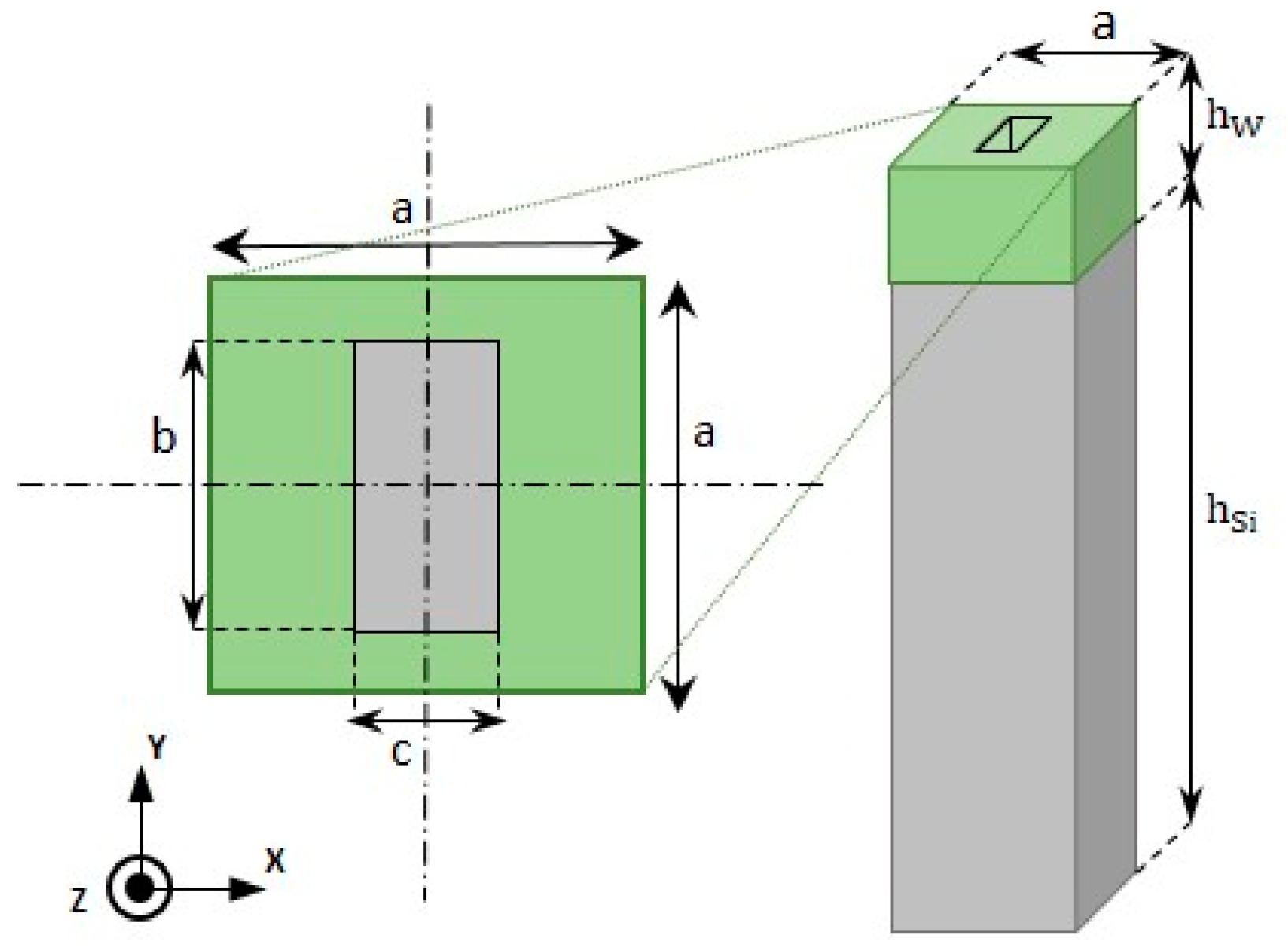
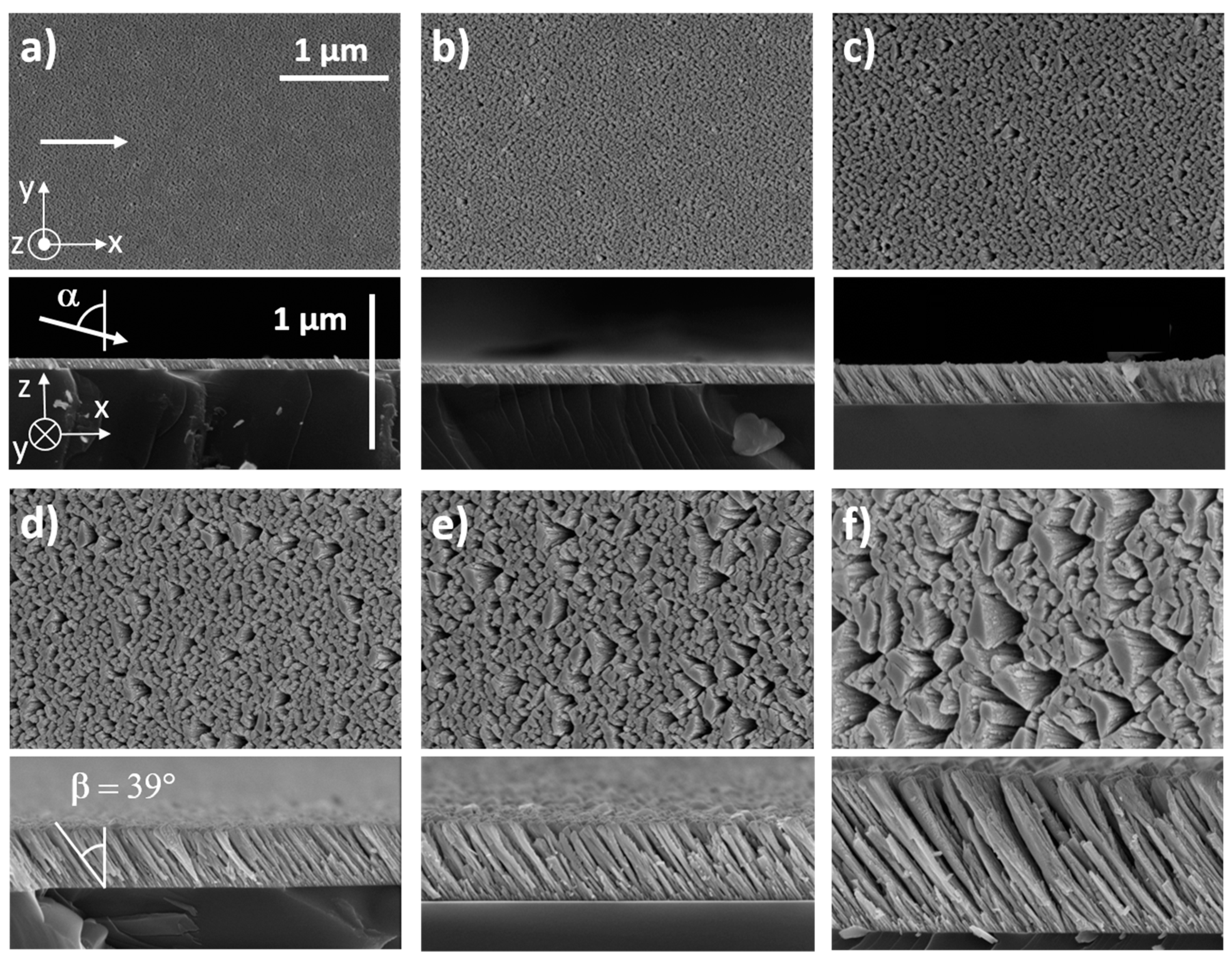
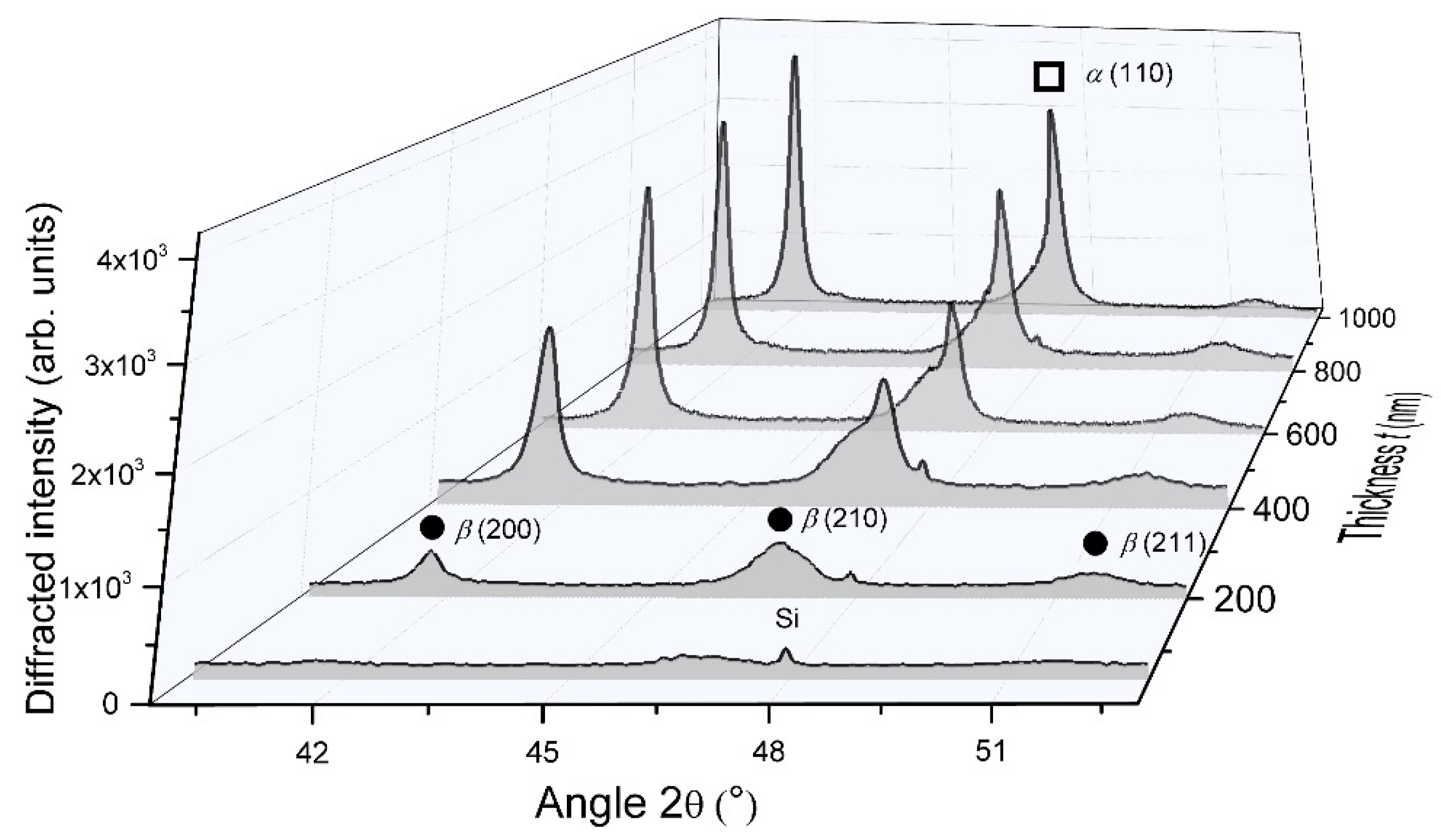
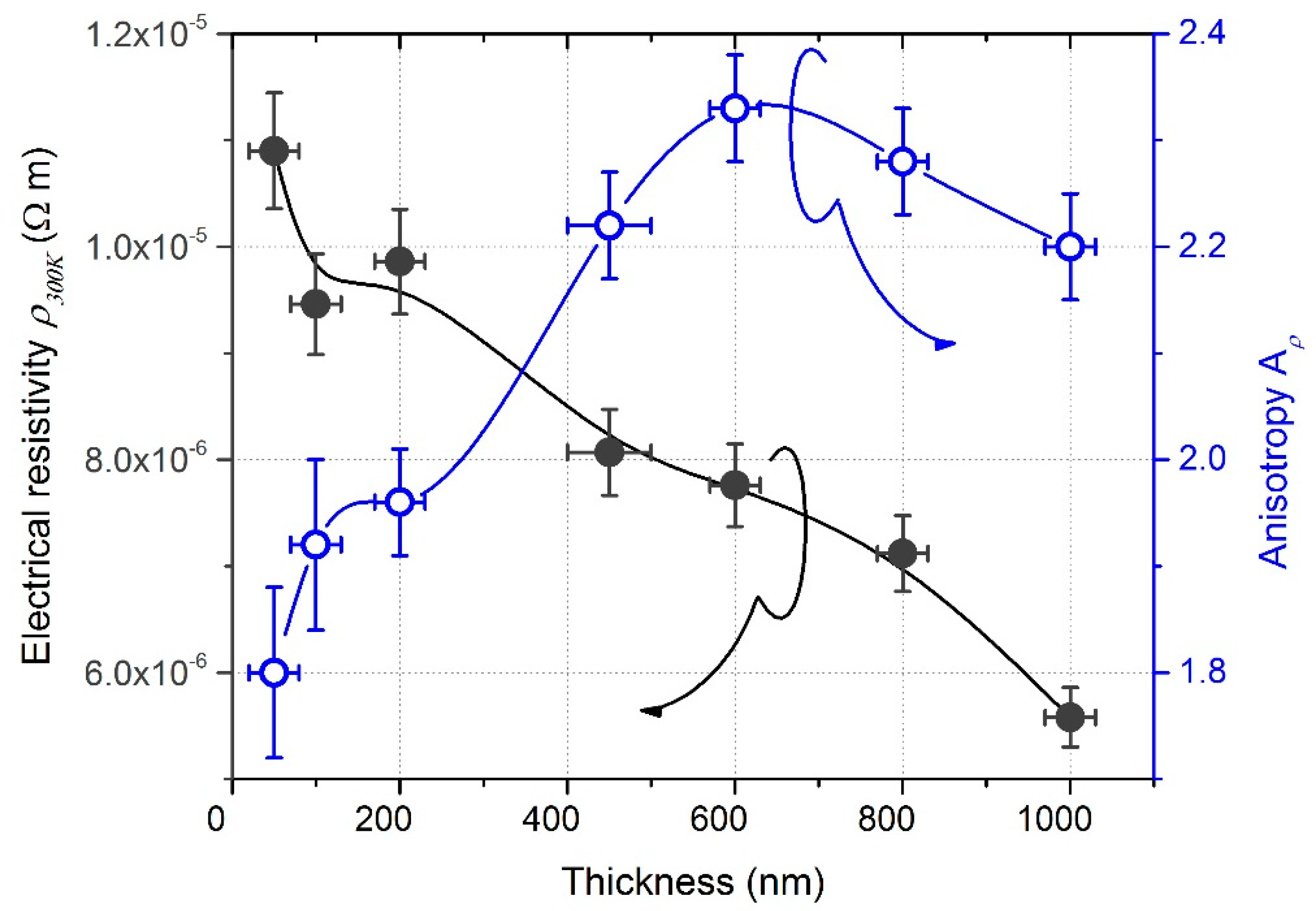
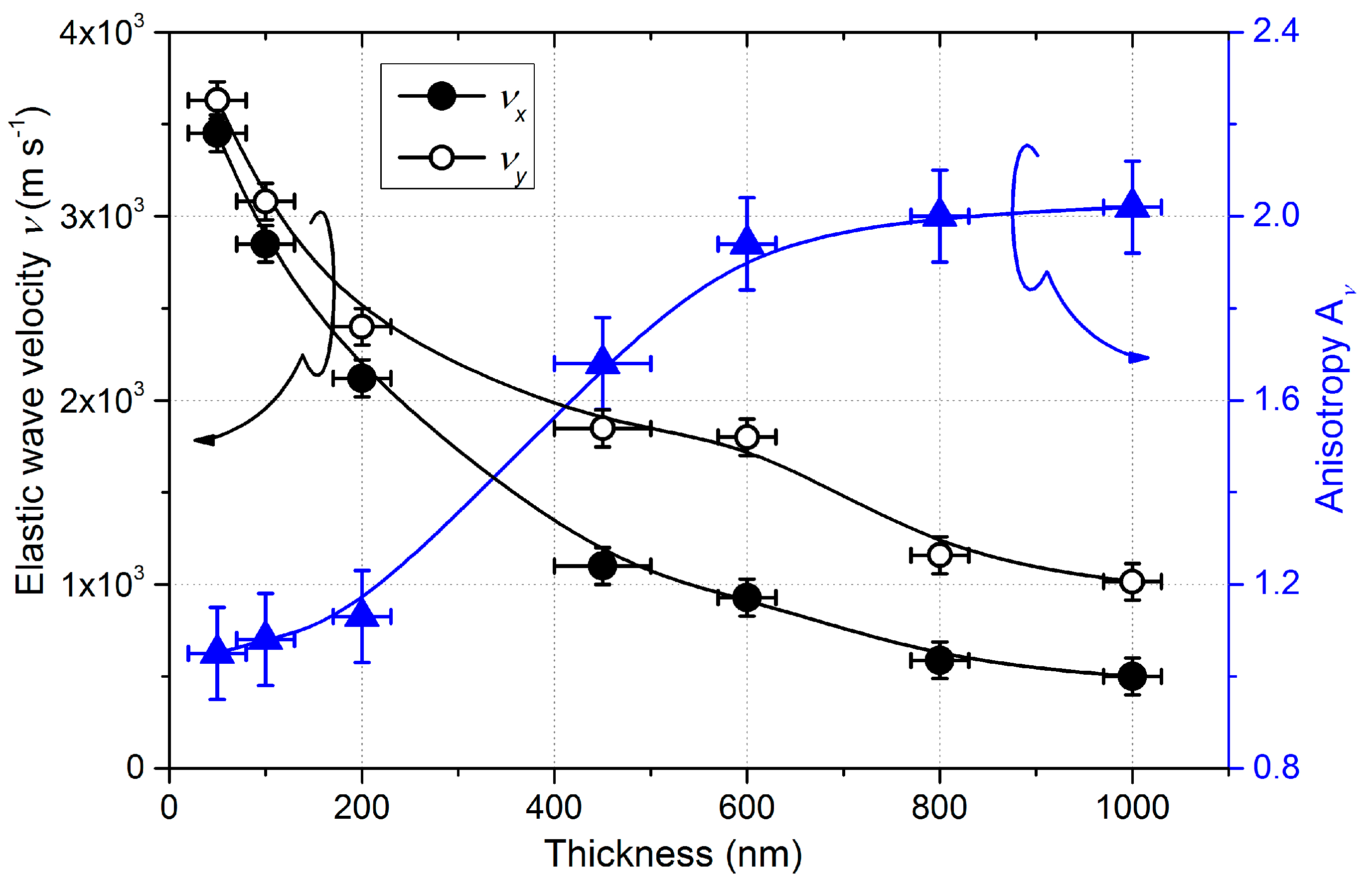
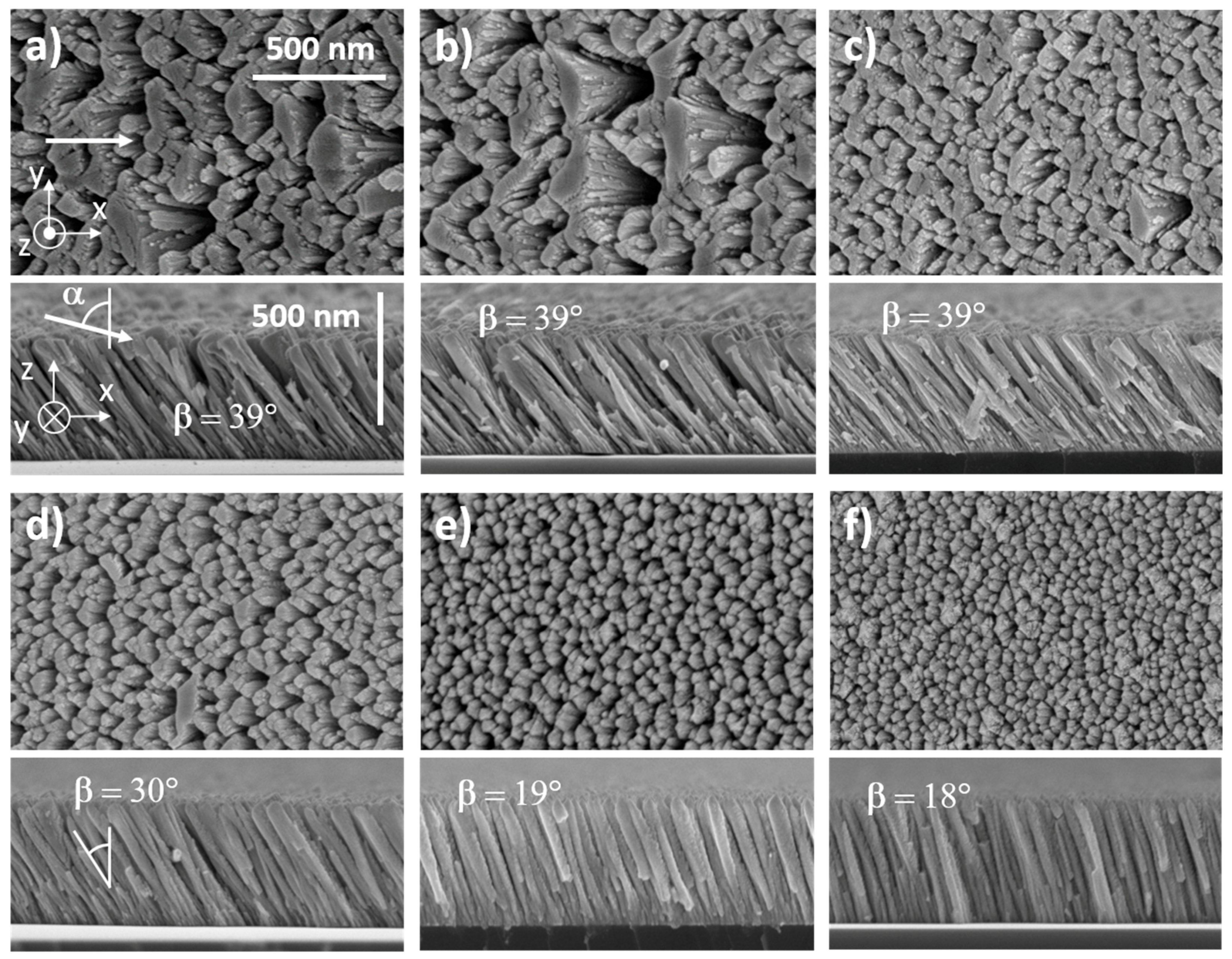

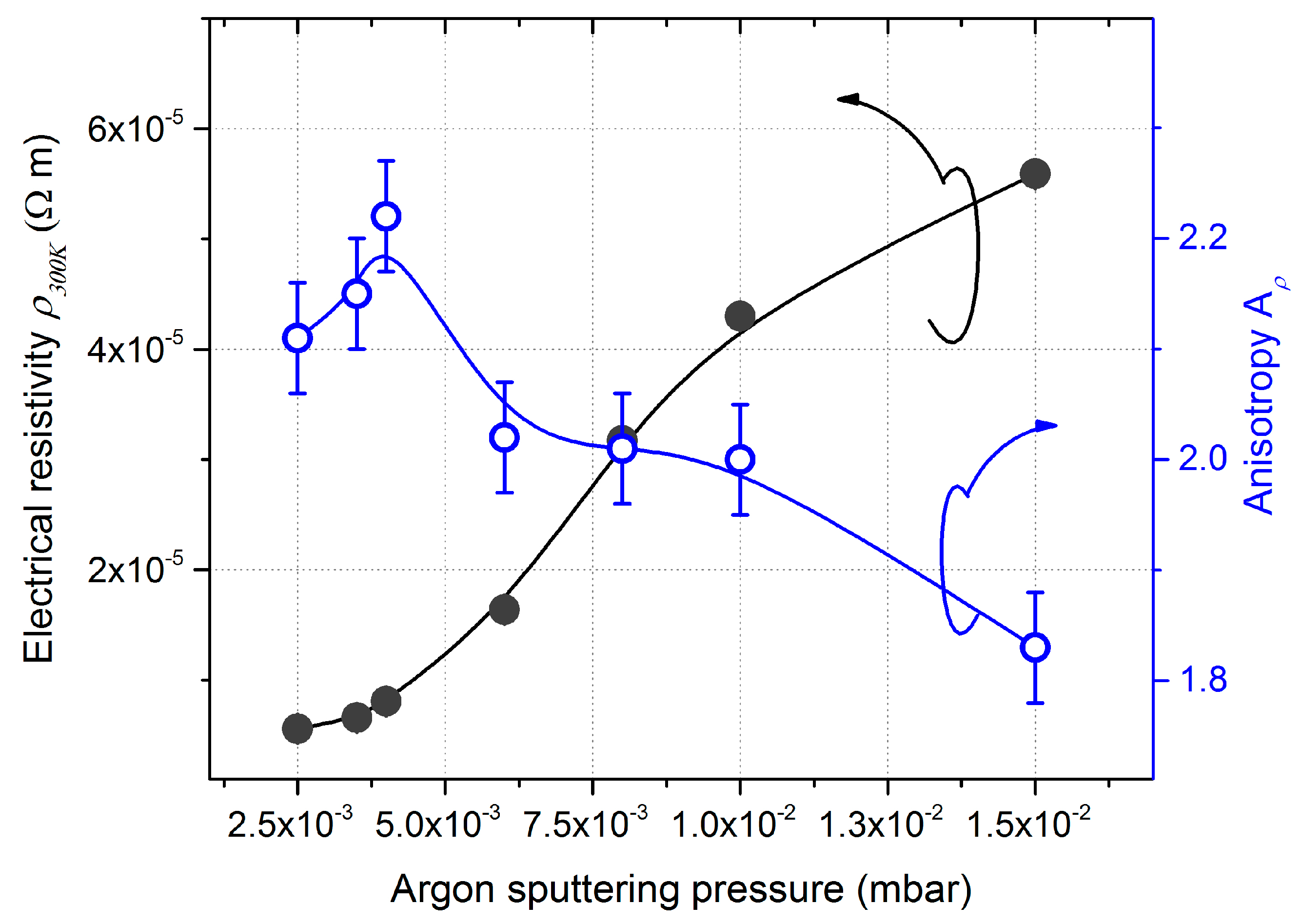
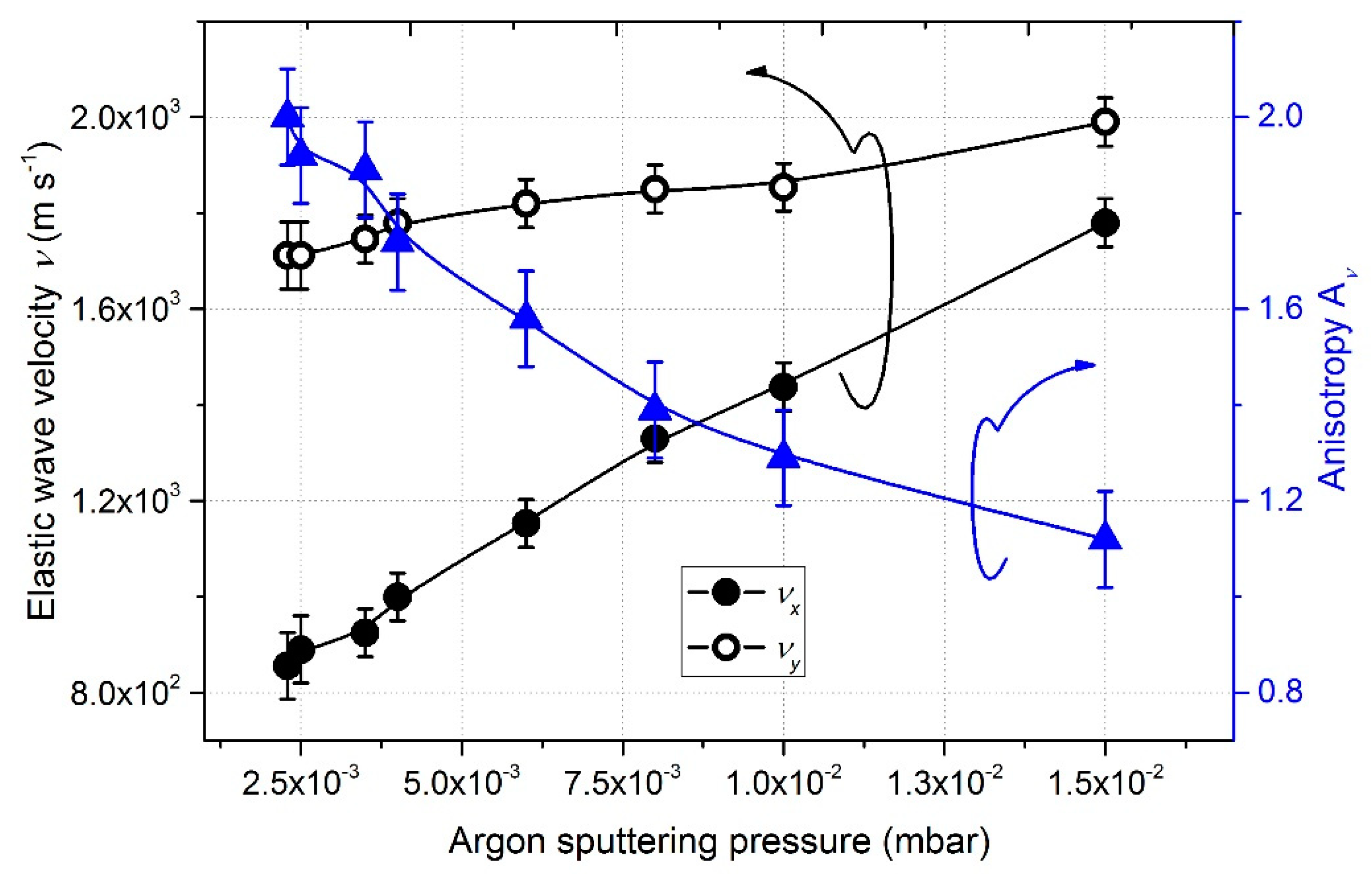
| Thickness (± 50 nm) | 100 | 200 | 450 | 600 | 800 | 1000 |
|---|---|---|---|---|---|---|
| Global porosity π (± 10% of the bulk) | 20 | 33 | 62 | 65 | 66 | 69 |
| Pressure PAr (× 10−3 mbar) | 2.5 | 3.5 | 4.0 | 6.0 | 8.0 | 10.0 | 15.0 |
|---|---|---|---|---|---|---|---|
| Global porosity π (± 10% of the bulk) | 68 | 65 | 62 | 59 | 55 | 53 | 46 |
© 2020 by the authors. Licensee MDPI, Basel, Switzerland. This article is an open access article distributed under the terms and conditions of the Creative Commons Attribution (CC BY) license (http://creativecommons.org/licenses/by/4.0/).
Share and Cite
Chargui, A.; El Beainou, R.; Mosset, A.; Euphrasie, S.; Potin, V.; Vairac, P.; Martin, N. Influence of Thickness and Sputtering Pressure on Electrical Resistivity and Elastic Wave Propagation in Oriented Columnar Tungsten Thin Films. Nanomaterials 2020, 10, 81. https://doi.org/10.3390/nano10010081
Chargui A, El Beainou R, Mosset A, Euphrasie S, Potin V, Vairac P, Martin N. Influence of Thickness and Sputtering Pressure on Electrical Resistivity and Elastic Wave Propagation in Oriented Columnar Tungsten Thin Films. Nanomaterials. 2020; 10(1):81. https://doi.org/10.3390/nano10010081
Chicago/Turabian StyleChargui, Asma, Raya El Beainou, Alexis Mosset, Sébastien Euphrasie, Valérie Potin, Pascal Vairac, and Nicolas Martin. 2020. "Influence of Thickness and Sputtering Pressure on Electrical Resistivity and Elastic Wave Propagation in Oriented Columnar Tungsten Thin Films" Nanomaterials 10, no. 1: 81. https://doi.org/10.3390/nano10010081
APA StyleChargui, A., El Beainou, R., Mosset, A., Euphrasie, S., Potin, V., Vairac, P., & Martin, N. (2020). Influence of Thickness and Sputtering Pressure on Electrical Resistivity and Elastic Wave Propagation in Oriented Columnar Tungsten Thin Films. Nanomaterials, 10(1), 81. https://doi.org/10.3390/nano10010081





